In a soccer match, victory can come down to a single detail: a sudden burst of speed, a long-range shot, a last-minute attack. However, what keeps a team from losing isn’t just a detail. On the contrary, it’s the tactic!
An effective tactic is essential to a team’s development. It plays a crucial role in destabilizing the opposition, creating gaps and scoring that all-important goal. So let’s take a closer look at this topic. Following our analyses of the 3-5-2, 3-4-3, 4-4-2 tactics, this article provides everything you need to know about the most widely used system of play: the 4-3-3
What is the 4-3-3 in soccer?
The 4-3-3 tactic is a formation made up of a back line of four defenders – two center-backs and two full-backs – positioned behind a midfield line of three players. In the most common midfield setup, there is one holding midfielder, known as the pivot, with two central midfielders positioned slightly higher on either side. The front line consists of two wingers, one of each flank and a single central striker.
Tactical systems and their analysis ultimately say very little on their own. It’s the team’s movement and guiding principles that truly matter to study. However, these systems provide a framework, an organization, a structure that bring much-needed discipline to a game that’s constantly in motion.
Occupying a 4,000-square-meter grass area inevitably requires a specific arrangement of players, regardless of our intentions.
So, it’s this structure that needs to be analyzed and how it moves and maintains its shape despite constant motion. Here, we’re focusing on the 4-3-3, a classic among formations, built around three key elements, unlike the four-element systems like the 4-2-3-1, which is a favorite of many coaches and offers great tactical flexibility.
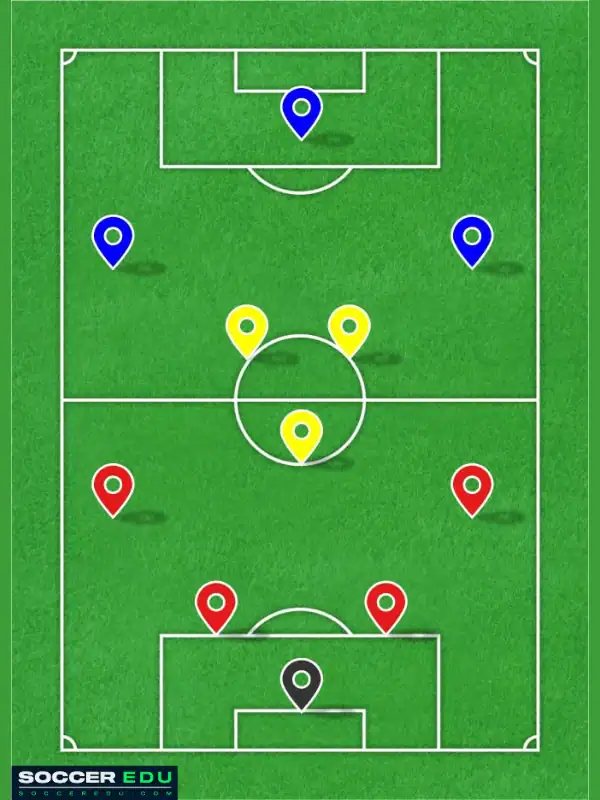
When to use a 4-3-3 formation?
As a coach, it’s essential for you to implement tactics as effectively as possible, which means understanding their nuances. The 4-3-3 formation can be broken down into two main variations: the “4-3-3 with a high pivot” and the “4-3-3 with a deep pivot”.
4-3-3 with a deep pivot
The 4-3-3 formation with a deep pivot features four defenders (two center-backs and two full-backs). A deep-lying central midfielder, often playing the role of a holding midfielder or “sentinel”, sits just in front of the defensive line. Their main task is to organize ball recovery and initiate the build-up play.
Two midfielders, known as wing-backs, who can push forward and connect with the three attackers (two wingers and a center-forward). This type of setup requires very versatile midfielders who are capable of both defending and attacking effectively.
4-3-3 with a high pivot
The 4-3-3 with a high pivot is similar to the 4-2-3-1, as it features two holding midfielders responsible for maintaining the team’s stability. There is also a central midfielder whose role is to coordinate play. Two wingers and a central striker complete the front line. However, the difference lies in the defensive aspect, as the first line is made up of three players tasked with locking down the central axis. The wide midfielders are responsible for protecting the flanks.
In the case of a 4-3-3 with a high pivot, the attackers are less involved defensively. This allows them to have enough energy to make a difference during the attacking phase.
Strengths of the 4-3-3
- Better control of the midfield during offensive phases.
- Easy-to-manage system that can be adapted into a 4-4-2 or 4-1-4-1.
- Encourages strong pressing.
- Promotes mobility. Attackers can alternate positions and so can midfielders.
- Facilitates the use of the entire width of the field in attack.
- For the 4-3-3 (with a deep pivot), it eases the transition into a 4-5-1 when possession is lost.
Weaknesses of the 4-3-3
- Defensively riskier because it can leave spaces open in midfield (requiring a shift to a 4-2-3-1 in defense for a better coverage).
- When possession is regained, the team effectively has only one striker since the two wide players drop back to defend deeper (still within the 4-2-3-1 defensive shape).
- Demands a lot of physical work from the wingers who transform into midfielders to defend and then immediately switch back to wide attackers as soon as the ball is recovered.
- Heavy responsibilities on the midfielders who must cover the many free spaces in the middle of the field inherent to this formation.
- Requires wide players capable of making overlapping runs (a profile that’s becoming increasingly rare)
- A fairly rigid system that demands players with specific profiles (versatile midfielders and wingers and a mobile, effective striker).
How to play the 4-3-3 tactic in soccer?
The 4-3-3 is a relatively challenging formation to manage because it requires a high level of technical skills. You need to understand and anticipate the movements of the attacking players.
Midfield setup in 4-3-3
The midfield is the core of the game – it’s where play is built and where the difference is made. In a 4-3-3 formation, numbers are not an issue. Three midfielders are more than enough to destabilize an opponent. However, it’s essential to choose them wisely so they can effectively create openings in the opposing half.
As shown in the images below, the 4-3-3 formation takes on two different forms depending on the structure of its three-man midfield. If the third midfielder is a so-called “deep pivot”, the 4-3-3 become a “defensive” 4-3-3, with the deeper player typically serving as a stabilizer or holding midfielder. If the third midfielder is a “high pivot”, often the classic number 10, the 4-3-3 becomes an “offensive” 4-3-3, featuring a player positioned slightly higher than the other two, tasked with orchestrating attacking phases and acting as the team’s playmaker.
In both forms, the 4-3-3 retains the very essence of what makes it popular: its midfield density. The greatest midfield trio in history, the famous Iniesta-Xavi-Sergio Busquets, operated in what is called a “defensive” three-man midfield.
Besides offering the chance to dominate the midfield, the 4-3-3 also enables coaches with plenty of energetic, aggressive players to showcase their strengths. The two wingers hold a crucial role in this setup, which contributes to its effectiveness: the ability to control play through three midfielders while expanding play wide with skillful flank players.
Optimization of the 4-3-3 formation in modern soccer
The 4-3-3 formation is a key strategy in soccer, offering flexibility between defensive and offensive approaches. The offensive 4-3-3 is especially effective for teams aiming to dominate in attack. Coaches looking to implement this tactic must adapt it to their players’ talents and skills, ensuring effective execution on the field.
Offensive and defensive setups and movements
Offensive formation in 4-3-3
In this game plan, it’s possible to have a three-player attack. This is an ideal number to disrupt an opponent’s stability. The forwards lead the offensive actions and are responsible for creating openings to score! Choosing the right attackers is far from easy, as they must be extremely technical, fast and able to shoot effectively from any position. In the 4-3-3 system, there is one striker and two wingers who absolutely must score goals.
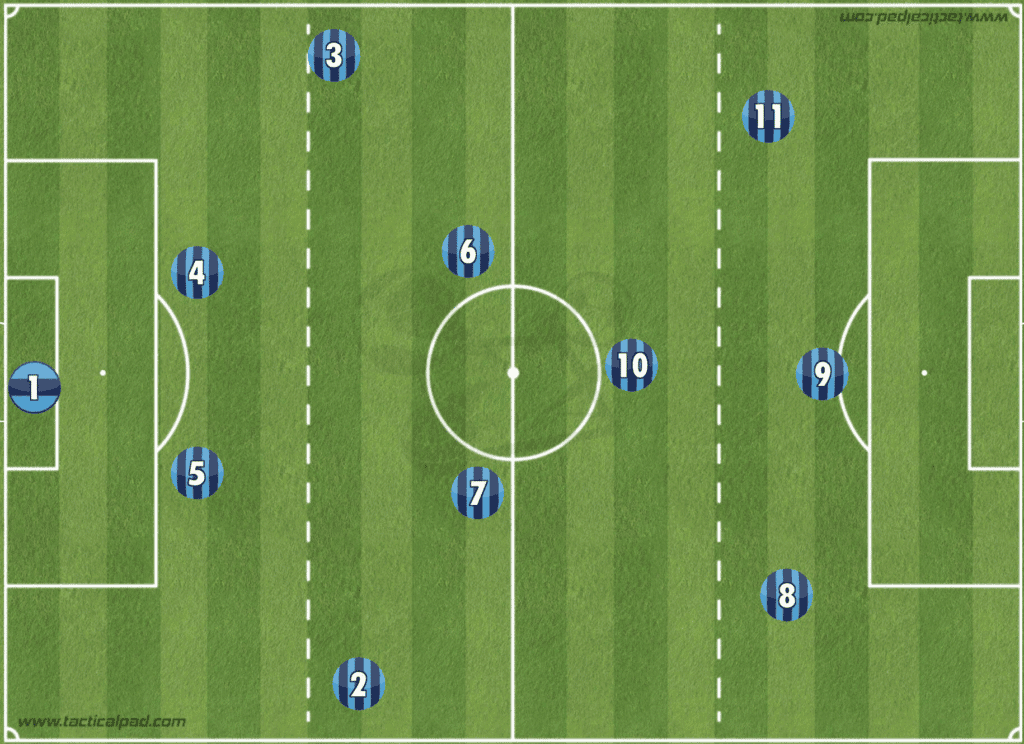
Offensive movement in a 4-3-3
One of the clearest indicators of a team’s work is the quality of its build-up play. In a 4-3-3, the ability to reshape and adapt is vast, offering numerous options. Here is a “typical” build-up pattern, although many variations exist. This structure is chosen to clearly illustrate the build-up principles withing a 4-3-3.
Several key points to observe:
- The right full-back (No.2) drops back to form a back three;
- The left full-back (No.3) takes advantage of this and push higher up the pitch;
- The deep-lying midfielder (No.6) positions himself centrally to offer a passing option.
In this setup, triangles are formed all over the field and each player potentially has three passing options.
Let’s suppose this tactical setup during the build-up is effective, the block settles in and now needs to unbalance a well-structured opponent.
In this system, the imbalance must come though movement and positional rotation. Interchanges between attacking players, assuming they are complementary, should be used to disrupt the opposing defense. One forward attacks the space in behind, while another drops deep to receive; an inverted winger combines with a full-back in his lane…There must be plenty of options for the midfielders tasked with feeding the attacking line.
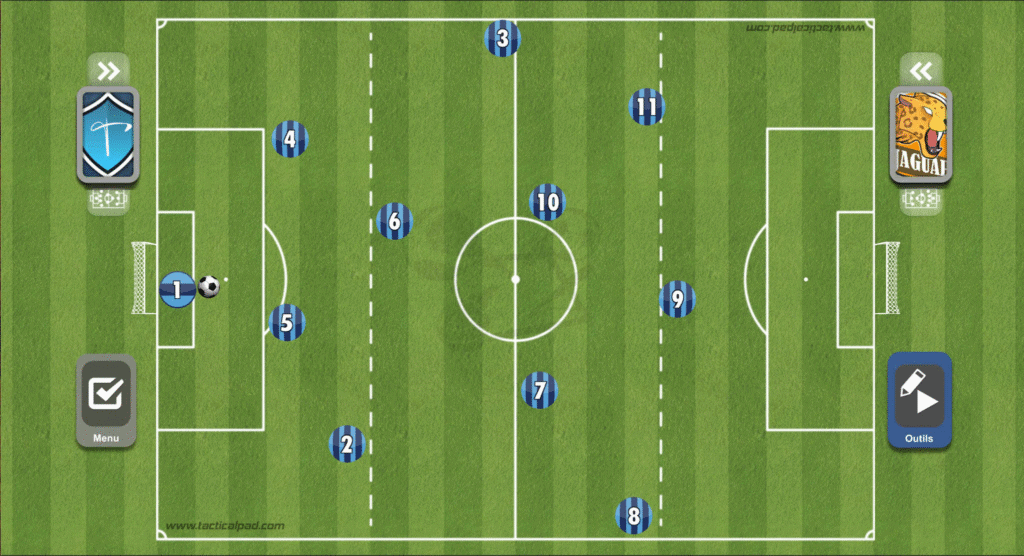
When speaking about the midfielders, they must go beyond their basic roles. While maintaining balance, they need to push forward and occupy the so-called “half-spaces” so dear to Pep Guardiola – this is the ideal zone to create imbalance.
By positioning themselves in these spaces, they allow the centre-backs to draw attention and then be found higher up than usual. In this situation, one player is tasked with linking the defensive line and the midfield; he acts as the safety net. All of this disrupts the opponent’s shape and places many players in the same zone, allowing for quick attacking combinations and effective counter-pressing.
Unlike the 4-4-2, the centrally-focused offensive setup described here increases the risk when possession is lost. That’s why many teams favor a wide attacking structure, with frequent overlapping runs from the full-backs, in order to minimize the risk during defensive transitions.
Defensive positioning in 4-3-3
A back line of four defenders, with two center-backs and two full-backs. Once again, player selection is crucial. The defensive line should include quick players on the flanks, though not overly offensive in their approach. The center-backs need to be strong and effective, particularly on set pieces such as free kicks and corners.
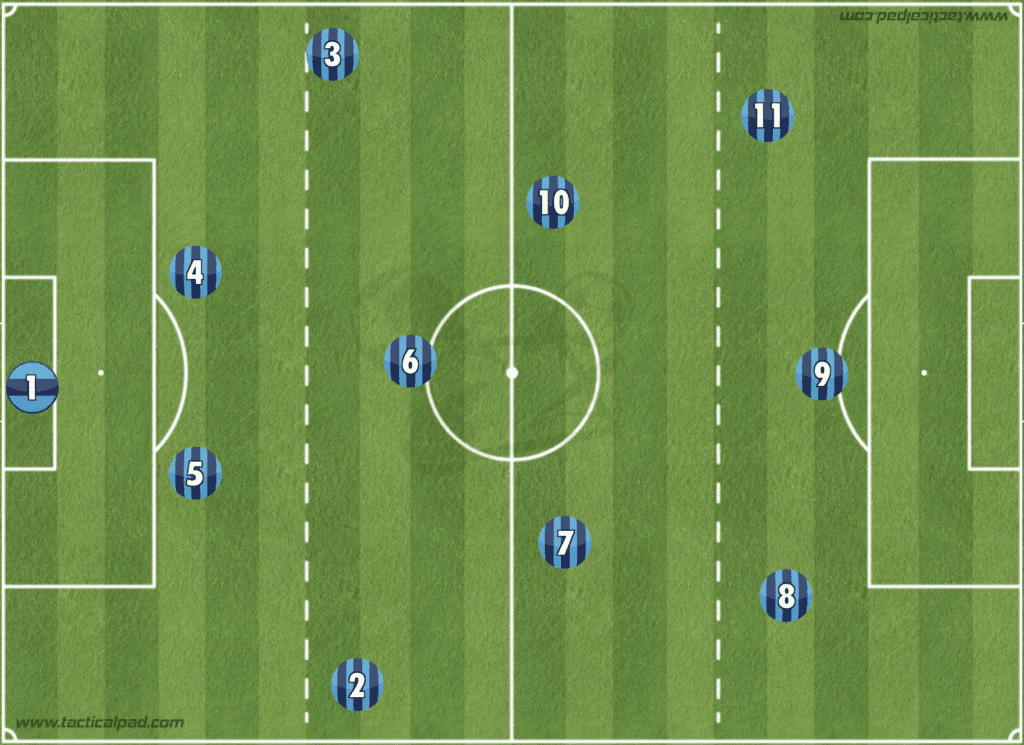
Defensive shape
The 4-3-3 changes its shape in defensive animation as soon as the behavior of its first line of pressure shifts. In a team that presses high during the defensive phase, the 4-3-3 remains a true 4-3-3 and can create a great deal of danger for the opponent.
Indeed, the three forwards pose a threat during the opponent’s build-up, forcing them to either clear the ball far from their goal or attempt very risky passes out from the back.
This strength of the first line of pressure can quickly turn into a weakness when the three forwards are not involved, coordinated and focused. This pressing requires alignment in individual behaviors, such as the shape of their runs, body orientation and so on… If this isn’t executed properly, the first line is quickly bypassed and the team is left defending with just the back four and the midfield three.
On the contrary, if the first line chooses to drop back as soon as the opponent gains possession, the team shifts into a 4-5-1 or even a 5-4-1 formation, which acts as a true wall across the width of the pitch, doubling up on the flanks, as seen in the 4-4-2.
However, this can prove very risky as the lone striker won’t be able to contain the opposing center-backs, who will be free to carry the ball forward and push up the block easily. In this setup, the team can quickly find itself pinned back in its own penalty area. That’s why many coaches emphasize the importance of having wingers positioned neither too high nor too deep, but rather in the right zones, ensuring both defensive balance and enough pressure on the opponent’s build-up.
The role of the midfielders can also vary, from marking zones to marking individual players… It’s usually a mix of covering defensive zones and tracking specific opponents individually.
Two midfielders can be tasked with tracking the key players and the main sources of the opponent’s attacking imbalance, in order to prevent them from finding space. Meanwhile, the “6” is responsible for maintaining balance by marking a specific zone in front of the defense. Another possible approach is to use a shifting block, with the opponent given relative freedom but with every zone on the field precisely covered. His is often not the players’ preferred setup, as it requires extreme concentration and strict discipline to maintain the shape of the block.
Case study: FC Barcelona (Spain) 2010/2011 under Pep Guardiola
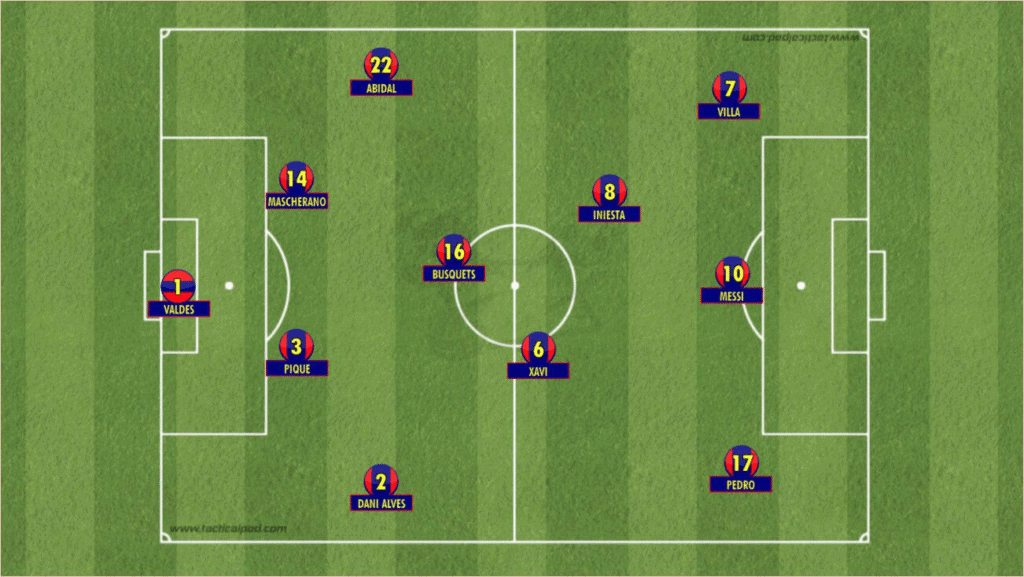
A masterclass and pinnacle of positional play, that season featured one of the greatest teams in soccer history. With a complementary and legendary midfield, it was a preview of what Pep Guardiola would later attempt to implement at Manchester City (England). Total soccer had never lived up to its name so well.
This example showcases excellence and highlights the monumental work that was done to develop such beautiful soccer to watch. This formation serves as an inspiration for many and has given rise to numerous young coaches who strive to learn from the greatest achievements.
It was Pep’s total soccer – my winning example.
Soccer drills to apply the 4-3-3
Here are some soccer drills to implement the 4-3-3 system.
Number of players: 16
Duration of exercise: 20 minutes
Equipment: balls, cones, pinnies/training vests
Drill #1
Offensive play
Setup: organization and instructions for playing in the 4-3-3 formation.
Double the number of players as needed. Alternate players between the right and left sides. All 10 players participate in the drill. Substitute players at the end of each action.
Sequence
- 3-player play between the central defenders and the defensive midfielders;
- Pass to a full-back;
- Support play on the forward;
- Pass to the midfielder who links up;
- Through ball to the wide player;
- Cross and shot.
Success criteria: Ensure good coordination of movements; maintain quick execution. Move during passing moments; keep balance and anticipate losing possession.
Drill #2
Attack-defense drill
Setup: organization and instructions
On half the field, 8 attackers (2 full-backs + 3 midfielders + 3 forwards) against 7 defenders (4 defenders + 3 midfielders). Goal= 1 point.
Scenario starts with the ball at midfield.
On the attackers’ side, they must use speed to unbalance the opponent. Defensive transition upon losing possession.
For the defenders, defend in zones. Offensive transition upon regaining possession.
Variations: limit shooting time and number of touches.
Success criteria: ensure smooth transition phases and respond effectively to the game situation. Coordinate movements.
In short, when playing in a 4-3-3, there are many possible formations. The appropriate setup depends on your club’s and players’ abilities, as well as the strengths and weaknesses of your opponent.
However, as our analysis shows, every tactic has its pros and cons. Your team’s strengths and weaknesses will therefore be the best guide in choosing which tactic to use.
Sources: Tactical Pad / Football Bloody Hell





